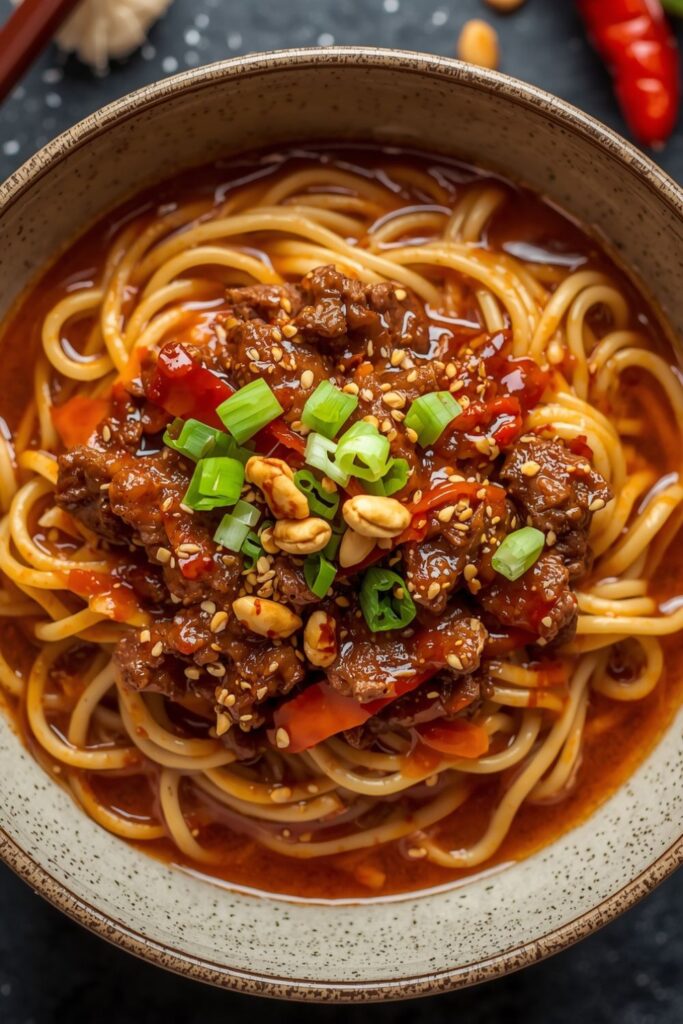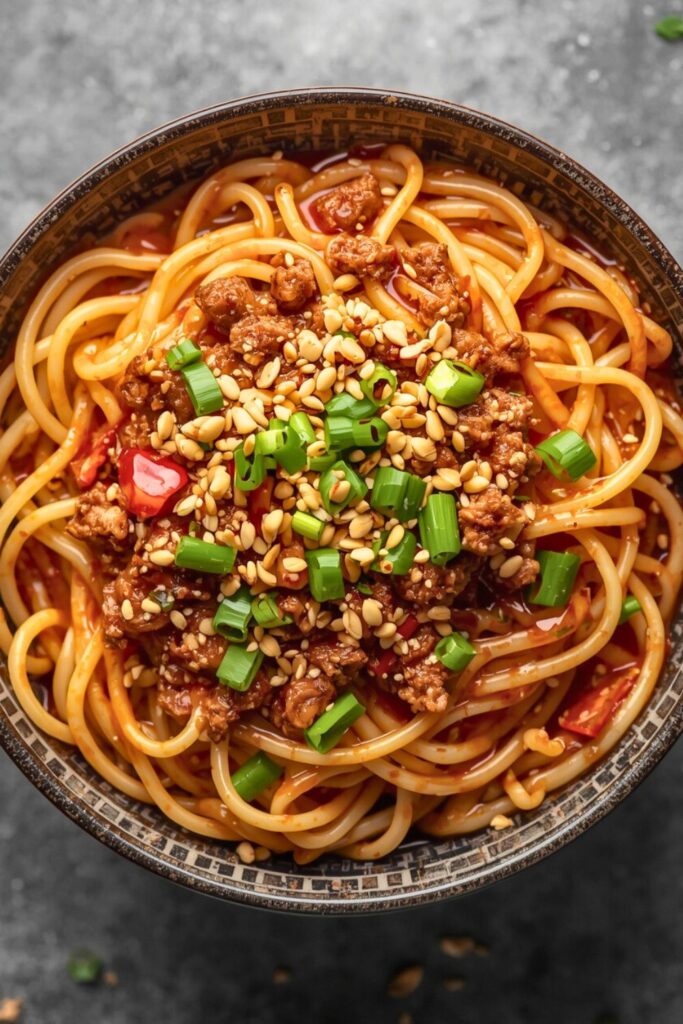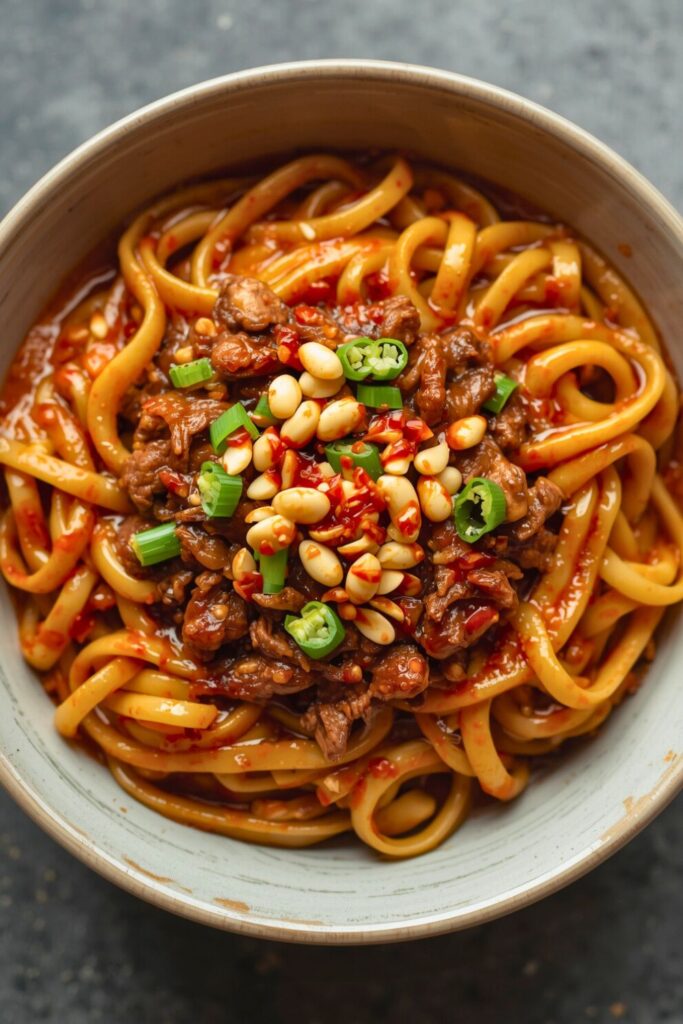Picture this: you’re walking down a narrow alley in Chengdu at 2 AM, stomach growling, when the most intoxicating aroma hits you like a warm hug. It’s nutty, spicy, and somehow familiar yet completely foreign. You follow your nose to a tiny stall where an elderly man is tossing noodles with the precision of a conductor leading an orchestra. That, my friend, is your first encounter with authentic dandan noodles, and trust me, it’s gonna change everything you thought you knew about comfort food.
Forget everything you’ve been told about Chinese takeout. This isn’t some watered down version designed for timid palates. Dandan noodles are the real deal, a street food masterpiece that’s been perfecting itself for over a century in the bustling alleys of Sichuan Province. The name literally means “carrying pole noodles” because vendors would balance their entire operation on bamboo poles, wandering the streets and serving up bowls of pure magic.
What makes these noodles so special isn’t just one thing, it’s the symphony of flavors that shouldn’t work together but absolutely do. You’ve got the deep, earthy richness of sesame paste dancing with the tongue tingling heat of Sichuan peppercorns. There’s the umami bomb of fermented black beans meeting the gentle sweetness of caramelized pork. And underneath it all, those perfectly chewy noodles that grab onto every drop of that incredible sauce.
Here’s what I love most about dandan noodles: they’re forgiving. Yeah, authentic is beautiful, but this dish welcomes your creativity with open arms. Can’t find ya cai (preserved mustard greens)? Your pickled vegetables will do just fine. No Shaoxing wine? A splash of dry sherry works wonders. This recipe adapts to your pantry and your preferences without losing its soul.
The Heart of Authentic Dandan Noodles

Let me tell you something that might surprise you traditional dandan noodles weren’t originally served in that rich, brothy sauce you might’ve seen at restaurants. Nope. The street vendors served them “dry style,” meaning the noodles got tossed with just enough sauce to coat every strand perfectly. No swimming, no soupy mess, just pure, concentrated flavor in every bite.
This authentic dandan noodles approach creates intense flavor without dilution.,
The magic happens in that sauce. It’s not complicated, but it is specific. You need that nutty depth from Chinese sesame paste (not tahini, they’re cousins, not twins). You want the gentle heat from chili oil that’s been properly made with whole spices. And you absolutely must have those Sichuan peppercorns that make your tongue tingle in the most wonderful way.
Essential Dandan Noodles Ingredients
Perfect Dandan Noodles Components
Fresh Chinese wheat noodles, Look for the slightly alkaline ones if you can find ’em. They’ve got that perfect chew that holds up to the sauce. Can’t find them? Japanese ramen noodles work beautifully, or even good quality spaghetti in a pinch.
Chinese sesame paste: This is different from Middle Eastern tahini. It’s toastier, richer, and way more intense. Find it at Asian markets, and once you taste the difference, you’ll never go back.
Sichuan peppercorns: These aren’t actually peppers at all. They’re the dried husks of a citrus tree seed, and they create this incredible numbing sensation called “mala.” Buy them whole and toast them yourself.
Chili oil with sediment: The good stuff has those beautiful red flakes settling at the bottom. That’s pure flavor gold right there.
Ground pork: Traditional uses ya cai (preserved vegetables) mixed with the meat, but we’re gonna build our own version that’s just as good.
The Smart Swaps
No Chinese sesame paste? Mix three parts tahini with one part toasted sesame oil. Not identical, but it’ll get you close enough to fall in love with the dish.
Sichuan peppercorns missing? A tiny pinch of white pepper plus a few pink peppercorns will give you some of that unique tingle.
Can’t find proper chili oil? Make your own by heating neutral oil to 275°F and pouring it over red pepper flakes mixed with a pinch of sugar and salt.
Ground pork not your thing? Turkey, chicken, or even crumbled firm tofu work beautifully. The key is getting good caramelization on whatever protein you choose.
Here’s something most recipes won’t tell you: the quality of your soy sauce matters tremendously. Get naturally brewed soy sauce without caramel coloring. Your dandan noodles deserve premium ingredients, and your taste buds will thank you later.
Perfecting Your Dandan Noodles Technique

The Sauce Foundation
Start with your sesame paste in a large mixing bowl. This stuff is thick: like, spoon stands up in it thick, so we gotta thin it out gradually. Add a tablespoon of hot water and whisk until it looks smooth. Then another tablespoon. Keep going until it flows like heavy cream.
Now comes the flavor building. Add two tablespoons of soy sauce (dark if you’ve got it, light works too). One tablespoon of Chinese black vinegar, or rice vinegar if that’s what’s in your pantry. A teaspoon of sugar to balance all that saltiness. Mix it until everything’s combined and beautiful.
Here’s where the magic happens: taste it. Yeah, right now, with a clean spoon. It should be salty, tangy, and rich. If it’s too thick, add more hot water. Too thin? More sesame paste. This is your canvas, and you’re the artist.
The Aromatic Oil
Heat two tablespoons of neutral oil in a wok or large skillet over medium heat. Toss in a tablespoon of whole Sichuan peppercorns and let them sizzle for about 30 seconds. You’ll smell that incredible citrusy fragrance, that’s when you know they’re ready.
Add your ground pork and break it up with a spoon. We want good caramelization here, so resist the urge to stir constantly. Let it sit for a minute, then stir. Repeat until the meat is golden brown and smells incredible.
Season with a pinch of salt and white pepper. Add a tablespoon of Shaoxing wine (or dry sherry) and let it sizzle off. The whole kitchen should smell like heaven right about now.
Bringing It All Together
Get your water boiling for the noodles. Fresh Chinese noodles usually take 2-3 minutes. Follow the package directions, but taste test 30 seconds before they should be done. You want them just slightly firmer than perfect, they’ll finish cooking in the residual heat.
While the noodles cook, warm your serving bowls. This isn’t fancy restaurant stuff, just rinse them with hot water. Trust me, cold bowls make the sauce seize up.
Drain the noodles (save a cup of that starchy cooking water, it’s liquid gold for adjusting sauce consistency). Immediately toss them with the sesame sauce. Add the pork mixture. Give everything a good mix until every strand is coated.
Too thick? Add pasta water gradually. Too thin? More sesame paste works perfectly. Perfect dandan noodles require sauce consistency adjustments for optimal coating.
The Science Behind the Sizzle
There’s actually some beautiful chemistry happening in your bowl right now. Those Sichuan peppercorns contain a compound called hydroxy alpha sanshool, which literally activates the touch receptors in your mouth. It’s not heat like from chili peppers, it’s a completely different sensation that makes everything else taste more intense.
The sesame paste brings more than just flavor. It’s loaded with healthy fats that help carry all those aromatic compounds to your taste receptors. That’s why everything tastes so much more vivid when it’s coated in that rich sauce.
When you brown the pork properly, you’re creating hundreds of new flavor compounds through the Maillard reaction. Those caramelized bits aren’t just for looks, they’re pure umami bombs that make your dandan noodles incredibly satisfying.
Here’s something cool: the slightly alkaline noodles actually enhance umami perception. That’s why authentic Chinese wheat noodles make dandan noodles exceptional. They’re not just sauce vehicles, they’re active flavor participants.
Making Your Dandan Noodles Beautiful
Traditional presentation is simple but striking. The noodles get twirled in the center of the bowl with the pork mixture spooned over the top. A sprinkle of chopped scallions adds color and freshness. Maybe a few extra Sichuan peppercorns for the brave souls.
But here’s where you can have some fun. A handful of blanched baby bok choy makes the bowl more substantial. Pickled mustard greens (or even kimchi) add that traditional fermented tang. A soft boiled egg with a jammy yolk? Pure indulgence.
For drinks, think about balance. The richness calls for something crisp and clean. A light lager, dry Riesling, or even iced jasmine tea cuts through the sesame beautifully.
The leftovers (if there are any) actually get better overnight. The noodles absorb more of that incredible sauce, and the flavors meld together even more. Just add a splash of hot water when reheating to loosen things up.
Creative Dandan Noodles Variations
Once you’ve mastered basic technique, dandan noodles become your creative playground. Want vegetarian? Skip pork and double fermented black beans for umami depth. Craving vegetables? Blanched spinach works beautifully.
For the heat lovers, add more chili oil or throw in some fresh chilies with the pork. Want it milder? Use sweet bean sauce instead of some of the soy sauce. The dish adapts to your preferences while keeping its essential character.
Some cooks add beaten egg to hot noodles, creating beautiful silky strands throughout. Others top dandan noodles with crushed peanuts for extra richness. There’s no wrong approach to personalizing this classic.
The Cultural Connection

Every time you make these noodles, you’re connecting with centuries of culinary tradition. Street vendors in Chengdu have been perfecting this balance of flavors for generations, each adding their own little twist while respecting the dish’s essential character.
In Sichuan, they say good dandan noodles should make you sweat a little and smile a lot. The “mala” sensation, that combination of numbing and spicy, is supposed to be intense but not overwhelming. It should wake up your palate, not knock it unconscious.
The beauty of street food like this is its honesty. There’s nowhere to hide when you’ve only got a handful of ingredients. Everything has to be perfect, the noodle texture, the sauce balance, the meat preparation. It’s simple food executed at the highest level.
Bringing It All Home
When you finally sit down with your bowl of homemade dandan noodles, take a moment to appreciate what you’ve created. This isn’t just dinner, it’s a connection to one of the world’s great culinary traditions, adapted for your kitchen and your taste.
The first bite should hit you with that incredible sesame richness, followed by the gentle heat and that unique Sichuan peppercorn tingle. The noodles should be perfectly chewy, the pork savory and aromatic, everything working together in harmony.
Don’t eat it slowly, dandan noodles are meant to be devoured while hot, with enthusiasm and probably a bit of sauce on your chin. That’s not messiness, that’s authenticity.
Remember, like any great dish, this gets better the more you make it. Your instincts for the sauce consistency will improve. You’ll develop preferences for spice levels and toppings. Before long, you’ll be making adjustments without even thinking about it, just like those street vendors in Chengdu who’ve been doing this dance for decades.
The best part? Once word gets out that you can make real dandan noodles at home, you’re gonna become everyone’s favorite dinner invitation. And trust me, that’s a responsibility worth taking seriously.
Frequently Asked Questions
Can I make the sauce ahead of time?
Absolutely! The sesame sauce actually gets better after sitting for a few hours. Make a big batch and store it in the fridge for up to a week. Just whisk in a bit of hot water to loosen it up before using. The pork mixture also keeps well and reheats beautifully.
What if I can’t handle spicy food?
The beauty of making this at home is controlling the heat level. Start with just a drizzle of chili oil and build up from there. You can also use sweet chili sauce instead of the spicy stuff. The dish is still incredibly flavorful without the fire.
Are there gluten free options for the noodles?
Rice noodles work, though they change the texture significantly. Look for the thicker, chewier varieties that can stand up to the rich sauce. Shirataki noodles are another option, though they’re quite different from traditional wheat noodles. The sauce is naturally gluten free if you use tamari instead of soy sauce.
Why does my sesame paste keep separating?
This usually happens when the paste is too cold or you’re adding liquid too quickly. Bring the sesame paste to room temperature first, then add hot water gradually while whisking constantly. If it does separate, just keep whisking, it’ll come back together.
Can I freeze portions for later?
The sauce freezes beautifully, but don’t freeze it with the noodles already mixed in. Cook fresh noodles and toss with thawed sauce for the best texture. The cooked pork mixture also freezes well for up to three months.

Swiftly Captions by Tina Smith — Quick, flavorful food recipes made simple, bringing fresh inspiration to your kitchen every day






